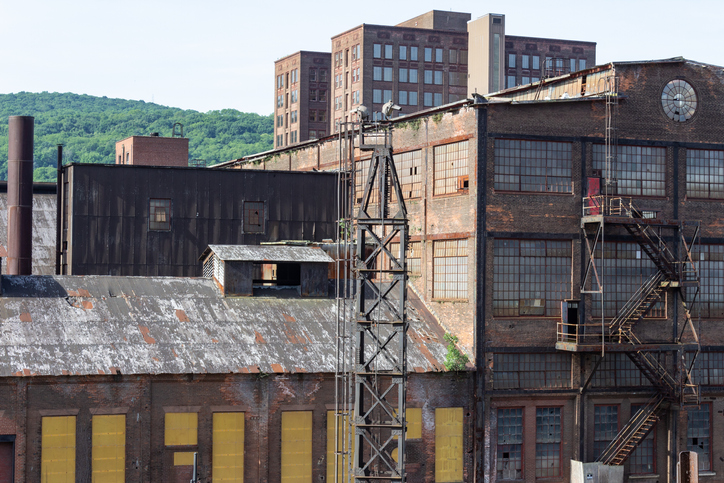“We cannot elect Democrats up and down the ballot, let alone protect our governing majorities, if we don’t address those losses ASAP …”
The Democrats have got an electoral problem!
This is according to Democrats themselves, some of whom have released a new report analyzing the results of recent federal elections in the industrial heartland. Its takeaway is this: The dominant political narrative that Democrats win urban areas, Republicans win rural areas, and the purple suburbs are up for grabs is too simplistic – and very misleading in those battleground states around the Great Lakes. There, in “manufacturing-heavy working-class towns that are not part of huge urban areas, but are not farming-dominated rural counties either,” Democrats in elections from 2012 to 2020 have been absolutely walloped. Thumped. Pounded! And while Democrats continued to make gains in these states’ major cities, they were almost completely erased by the losses in these “’factory town’ counties.”
That’s a serious problem for winning presidential elections, because … you know, if you don’t win these states, you don’t control the White House. From the report (and please remember, this was written by Democrats):
“This part of the country swung heavily to [former President Barack] Obama in 2008, not quite so decisively in 2012, and then went enough toward [former President Donald] Trump to give him his electoral college victory in 2016. Joe Biden won enough of it back in 2020 to allow him the victory, but in spite of Trump’s disastrous presidency, it was way too close for comfort.
“Voters in these states’ cities and suburbs moved significantly toward the Democrats, and this movement allowed Biden’s victory. The Democratic presidential candidates picked up almost 541,000 votes in the biggest cities in the states/counties studied, and more than 506,000 votes in the suburban counties of those big cities. They also added to their vote margin in the smaller towns dominated by big colleges and universities, picking up 140,000 plus from their 2012 margins. But outside the biggest metro areas and those college towns, Democrats lost a massive amount of ground — and the more those local economies were tied to manufacturing, the more ground they lost.”
The report goes on to note two big correlations that went along with Democrats’ losses in these places: A precipitous (precipitous) decline in union membership and a steep loss of manufacturing jobs. But it doesn’t offer any prescriptions for how to fix this mounting political problem. Rather, it’s instead focused on identifying the location of the Democrats’ problem so they can then get around to solving it:
People who run political campaigns must correctly answer key questions related to the Who, What, When, Where, Why and How of the venture. This is true for any complex human endeavor. Political minds tend to immediately focus on Who (the candidate), Why (the case for the candidate), What (policy positions), and How (campaign strategy and tactics). This study says let’s try something a little different. Let’s first focus on Where – the small and midsize Factory Town counties – to figure out how to build a lasting and permanent Democratic majority. MAGA voters are not the target.
Now, far be it from me or the Alliance for American Manufacturing to offer Democrats tips on how to win elections in the industrial heartland – we are proudly nonpartisan, after all – but I can think of a few ways to win elections in towns where the employment base has been vaporized by decades of offshoring! Heck, more than a few. We wrote an entire series of blogs on this back in December. We called it the Build Back Better Blueprint, a nod to then President-elect Joe Biden’s proposed economic agenda. Anyway, here are a handful of policy suggestions that would address the downturn of American industry in these crucial political districts:
Use the power of federal spending and procurement to create demand that domestic manufacturing can grow on. I’m talking, of course, about Buy America, which isn’t exactly rocket science. When our government spends to repair public infrastructure, it should be looking to its own manufacturers first.
Create widespread training programs to align the workforce with the jobs that are available. There are plenty of factory jobs available in the United States, many of them relatively lucrative. It’s incumbent on both the private and public sectors in this country to make sure we have the qualified workers to fill them. That should start with doing away with the accusatory “skills gap” nonsense that lays this at workers’ feet and it should be followed by legitimate investment to address the problem.
And get serious about trade enforcement, especially with China. This is the big one, as a major expansion of trade with China in 2000 – brought to you by Democrats and Republicans alike – was a major reason behind approximately 12 years of manufacturing employment freefall in the United States. The Biden administration is approaching the economic relationship with China cautiously. President Biden talked the talk a lot on the campaign trail when discussing our warped trade relationship with the state-directed economy that’s soon to be the largest economy in the world. Now, with a “virtual meeting” (Zoom call, let’s be honest) between the president and China’s Xi Jinping on the calendar, he’s gotta walk the walk. We’re not gonna even feint at building back the domestic manufacturing base until an American president actually does so.
Obviously, more job training, Buy America rules and tougher trade enforcement alone aren’t going to reverse Democratic fortunes in decimated manufacturing communities. But pro-manufacturing policy is clearly going to be part of the solution that the Democrats have yet to settle on. This report, in my opinion, correctly identifies a real problem for their presidential electoral prospects. It will be interesting to see if they are able to fix it.
